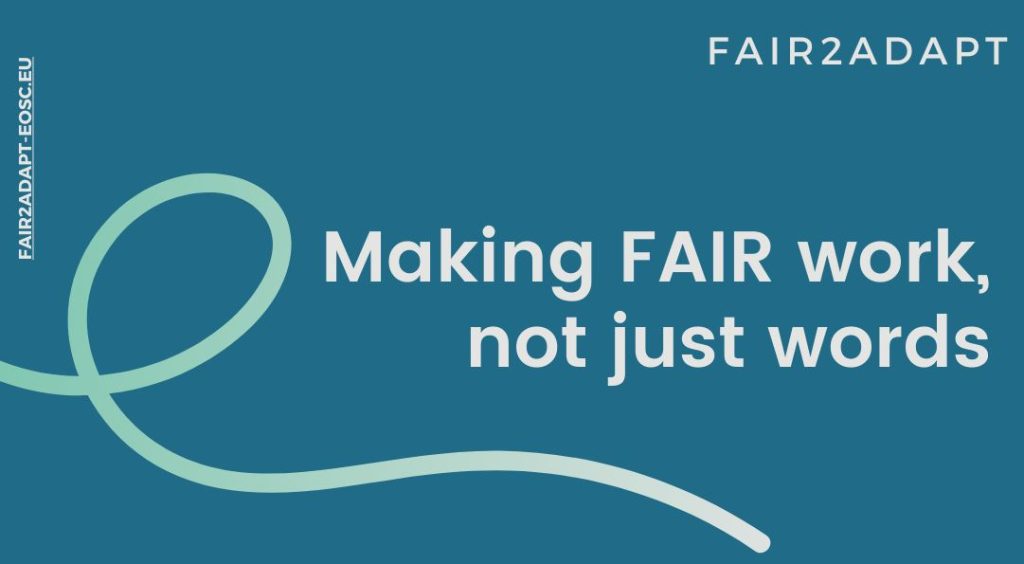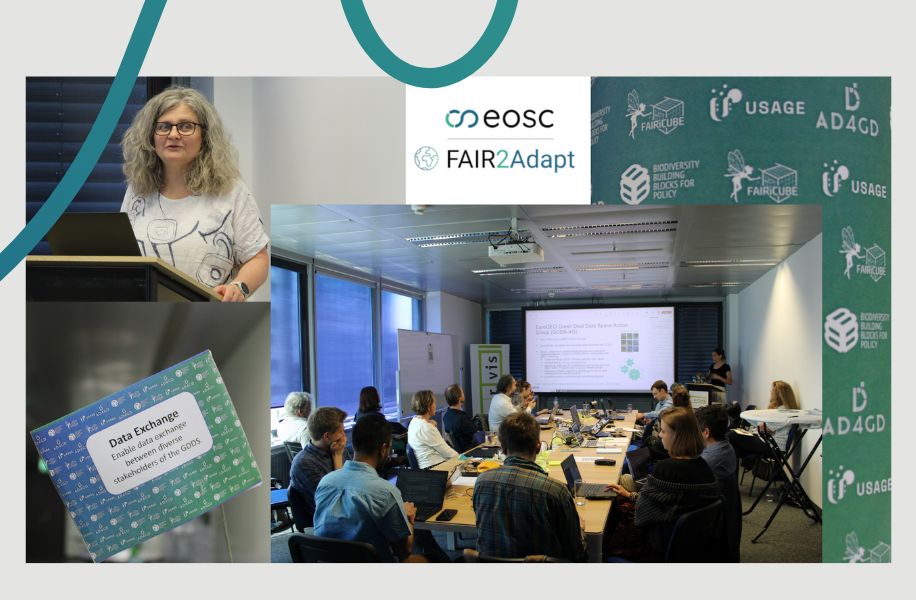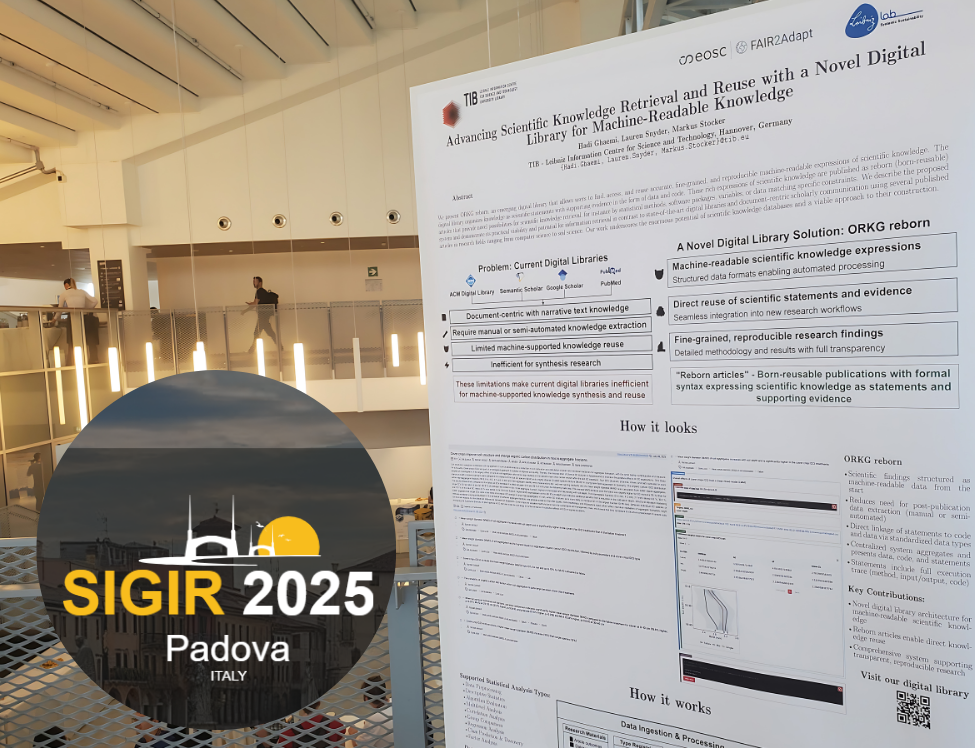June 2025 | From LPS25 Vienna to Green Deal Data Space Developments
June 2025 marked a pivotal moment for FAIR2Adapt and the FAIR data implementation in Earth observation and climate science. At the Living Planet Symposium 2025 (LPS25) in Vienna, Barbara Magagna presented her work on FAIR Digital Objects, while simultaneously, the “Three Years of Experience Developing the Green Deal Data Space” meeting (June 24-25) brought together key stakeholders from AD4GD, B-Cubed, FAIRiCUBE, and USAGE projects. Together, these events highlighted an important milestone: the I-ADOPT framework is making true FAIR implementation possible at scale.
The FAIR Implementation Challenge: From Principles to Practice

For years, the scientific community has embraced FAIR principles – making data Findable, Accessible, Interoperable, and Reusable. But there’s been a persistent gap between knowing what FAIR means and implementing it in practice. The work presented at LPS25 and discussed across multiple projects lies in the I-ADOPT (Interoperable Descriptions of Observable Property Terminology) framework.
I-ADOPT: The Missing Piece of FAIR Implementation
I-ADOPT, developed by the Research Data Alliance working group, functions as a “semantic broker” that finally makes the “I” in FAIR – Interoperability – practically achievable. Instead of requiring communities to abandon their existing terminologies, I-ADOPT provides a systematic way to describe variables using standardized components:
- Property: What characteristic are we measuring? (e.g., concentration, direction, level)
- Object of Interest: What are we observing? (e.g., nitrate, wind, water)
- Context Object: Where is this happening? (e.g., lake, atmosphere, urban area)
- Matrix: What medium contains our object? (e.g., precipitation, soil, air)
- Constraints: Any additional specifications (e.g., “baseline is lake floor”, “due to senescence”)
This decomposition transforms complex variable descriptions like “mean dissolved nitrate molar concentration per unit volume in precipitation water” into machine-readable, automatically linkable semantic structures.
The Challenge We’re Solving
The Earth Observation community is generating unprecedented amounts of data – new products, methods, and algorithms that are critical for addressing grand challenges like climate change adaptation and biodiversity conservation. But here’s the problem: much of this valuable data remains siloed, difficult to find, and challenging to reuse across different research contexts.
The solution? FAIR Digital Objects (FDOs) – a systematic approach to making data Findable, Accessible, Interoperable, and Reusable, while ensuring it’s both human-understandable and machine-interpretable.
Real-World FAIR Implementation: From Arctic to Urban Environments
The power of I-ADOPT-enabled FAIR implementation is being adopted across multiple projects and domains. FAIR2Adapt, presented by Barbara Magagna at LPS25, showcases how this framework will enable practical FAIR implementation across six diverse climate adaptation use cases:
Arctic environmental monitoring, coastal biodiversity conservation, urban climate resilience, national adaptation frameworks, global knowledge connectivity, and business climate risk assessment — each of these use cases will apply the I-ADOPT framework and I-ADOPT service to systematically decompose observable variables, enabling data to be more findable and reusable across scientific domains and institutional boundaries.
The Technical Stack: I-ADOPT-Enabled FAIR Digital Objects
Building on the I-ADOPT foundation, practical FAIR implementation combines several cutting-edge approaches:
I-ADOPT Integration with OGC Standards
The framework integrates seamlessly with OGC Observations, Measurements and Samples (OMS) standards and the SensorThings API, enabling automatic semantic annotation of time series data. This means research datasets become automatically discoverable and linkable across different projects and institutions.
FAIR Digital Objects as Research Objects
The FAIR2Adapt project leverages Research Object Crates (RO-Crates) to package data with metadata, creating self-contained digital objects that are both human-readable and machine-interpretable. These aren’t just data files – they’re complete, actionable knowledge packages.
Using the I-ADOPT (Interoperable Descriptions of Observable Property Terminology) framework, FAIR2Adapt breaks down complex climate variables into standardized, machine-readable components. This means that a measurement of “mean dissolved nitrate molar concentration per unit volume in precipitation water” becomes automatically linkable across different research projects and institutions.
Three-Point FAIRification Framework (3PFF)
FAIR2Adapt applies the 3PFF framework developed by the GO FAIR Foundation, providing practical “how-to” guidance for stakeholders seeking to “go FAIR.” This isn’t theoretical – it’s operational guidance that scientists, policymakers, and businesses can use immediately.
AI-Powered Annotation Services
Perhaps most excitingly, FAIR2Adapt is developing LLM-based annotation services that can automatically extract variable descriptions from free text and map them to I-ADOPT patterns. Researchers will be able to describe their observations in natural language and receive proper semantic annotations automatically.
Broader Impact: Green Deal Data Space and Beyond
The significance of I-ADOPT-enabled FAIR implementation extends beyond FAIR2Adapt and other individual projects. In parallel with LPS25, the separate “Three Years of Experience Developing the Green Deal Data Space” meeting (June 24-25) brought together projects AD4GD, B-Cubed, FAIRiCUBE, and USAGE to share achievements on Green Deal Data Space (GDDS) activities.
These projects, while addressing different aspects of environmental data management, all face the same fundamental challenge: how to make diverse datasets truly interoperable. The I-ADOPT framework provides a common solution that works across domains – from biodiversity monitoring to atmospheric research to urban planning.
A Community Ready for FAIR Implementation
The convergence of these developments – from LPS25 presentations to Green Deal Data Space progress – signals that the Earth observation community has reached a critical threshold. We’re moving from FAIR as aspiration to FAIR as implementation.
This shift is evident in:
- Technical maturity: I-ADOPT and related frameworks provide concrete implementation paths
- Community adoption: Multiple major projects are embracing these approaches
- Policy alignment: EU initiatives like the Green Deal Data Space are driving coordinated implementation
- Tool availability: AI-powered annotation services and automated workflows are making FAIR accessible to all researchers
The Tools Are Here, The Future Is Collaborative
Walking through the Austria Center Vienna, surrounded by 6,000+ Earth observation professionals, it was clear how far the field has come and how much potential lies ahead. The technologies demonstrated at LPS25 – from JupyterGIS for collaborative analysis to AI-powered semantic annotation – are not just research prototypes. They’re ready-to-use tools that can transform how we approach climate science.
But the real transformation isn’t technological – it’s cultural. It’s about building a research ecosystem where data sharing is the default, where semantic interoperability enables unprecedented collaboration, and where the barriers between disciplines dissolve in service of our shared mission: understanding and protecting our planet.
Get Involved with FAIR Implementation
The momentum around I-ADOPT and FAIR implementation is building across multiple fronts. Here’s how to engage:
Explore I-ADOPT:
- I-ADOPT Examples
- I-ADOPT Visualizer
- I-ADOPT Workshops: Participate in modeling challenges and community discussions
Apply FAIR Implementation:
- FAIR2Adapt Project
- Green Deal Data Space Projects: Engage with AD4GD, B-Cubed, FAIRiCUBE, USAGE initiatives
- FAIR Implementation Profiles: Develop community-specific FIPs using I-ADOPT
Join the Technical Community:
- Pangeo Community for open-source geoscience tools
- OGC Standards Development: Contribute to semantic interoperability standards
- RDA Working Groups: Participate in Research Data Alliance activities
The future of Earth observation is FAIR, and that future is being built now through systematic implementation approaches like I-ADOPT. We’re not just talking about FAIR anymore – we’re making it real.
This post highlights the progress in FAIR implementation enabled by the I-ADOPT framework, as demonstrated at LPS25 and across multiple EU projects. The focus on practical FAIR implementation represents a critical turning point for Earth observation and climate science communities. Anne Fouilloux is a Senior Research Engineer at Simula Research Laboratory and a contributor to I-ADOPT framework development.
About I-ADOPT: The I-ADOPT framework, developed by the Research Data Alliance, provides a systematic approach to describing observable properties that makes true semantic interoperability possible. It represents the missing piece that transforms FAIR from aspiration to practical implementation across scientific domains.



